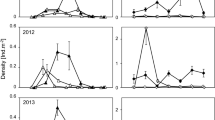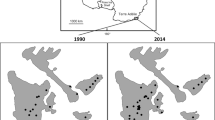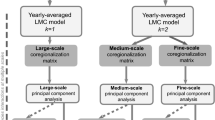Abstract
In a changing environment, the maintenance of communities is subject to many constraints (phenology, resources, climate, etc.). One such constraint is the relationship between conspecifics and competitors. In mixed colonies, seabirds may have to cope with interspecific and intraspecific competition for both space and food resources. We applied competitive interaction models to data on three seabird breeding populations: black-legged kittiwake (Rissa tridactyla), common guillemot (Uria aalge) and Brünnich’s guillemot (Uria lomvia) collected over 27-years at Kharlov Island in the Barents Sea. We found a competitive effect only for the kittiwake breeding population size on the common guillemot breeding population size when kittiwakes were abundant. The timing of kittiwake breeding negatively affected the number of breeding Brünnich’s guillemots. The timing of breeding was negatively correlated to biomass of the main pelagic fish in the Barents Sea, the capelin (Mallotus villosus), which suggests an indirect action. The community matrix shows that the community was not stable. The kittiwake population did not decrease as seen in north Norwegian populations. Likewise, the common guillemot population, after a crash in 1985, was recovering at Kharlov while Norwegian populations were decreasing. Only the Brünnich’s guillemot showed a decrease at Kharlov until 1999. We suggest that the stability of the kittiwake and common guillemot populations at Kharlov is due to better feeding conditions than in colonies of the Norwegian coast, linked to a possible eastward shift of the capelin population with the temperature increase of the Barents Sea.


Similar content being viewed by others
References
Andersen T, Carstensen J, Hernandez-Garcia E, Duarte CM (2009) Ecological thresholds and regime shifts: approaches to identification. Trends Ecol Evol 24:49–57
Anker-Nilssen T, Bakken V, Strøm H, Golovkin AN, Bianki VV, Tatarinkoa IP (2000) The status of marine birds breeding in the Barents Sea region. Norwegian Polar Institute, Tromsø
Ashbrook K, Wanless S, Harris MP, Hamer KC (2010) Impacts of poor food availability on positive density dependence in a highly colonial seabird. Proc R Soc Lond B 277:2355–2360
Barrett RT (2007) Food web interactions in the southwestern Barents Sea: black-legged kittiwakes Rissa tridactyla respond negatively to an increase in herring Clupea harengus. Mar Ecol Prog Ser 349:269–276
Barrett RT, Krasnov YV (1996) Recent responses to changes in stocks of prey species by seabirds breeding in the southern Barents Sea. ICES J Mar Sci 53:713–722
Barrett RT, Bakken V, Krasnov JV (1997) The diets of common and Brünnich’s guillemots Uria aalge and U. lomvia in the Barents Sea region. Polar Res 16:73–84
Boulinier T, Danchin E (1996) Population trends in Kittiwake Rissa tridactyla colonies in relation to tick infestation. Ibis 138:326–334
Boulinier T, McCoy KD, Yoccoz NG, Gasparini J, Tveraa T (2008) Public information affects breeding dispersal in a colonial bird: kittiwakes cue on neighbours. Biol Lett 4:538–540
Brander KM (2010) Cod Gadus morhua and climate change: processes, productivity and prediction. J Fish Biol 77:1899–1911
Camphuysen CJ, Scott BE, Wanless S (2006) Distribution and foraging interactions of seabirds and marine mammals in the North Sea: multispecies foraging assemblages and habitat-specific feeding strategies. In: Boyd IL, Wanless S, Camphuysen CJ (eds) Top predators in marine ecosystems: their role in monitoring and management. Cambridge University Press, Cambridge, pp 82–97
Carscadden JE, Montevecchi WA, Davoren GK, Nakashima BS (2002) Trophic relationships among capelin (Mallotus villosus) and seabirds in a changing ecosystem. ICES J Mar Sci 59:1027–1033
Cherel Y, Ducatez S, Fontaine C, Richard P, Guinet C (2008) Stable isotopes reveal the trophic position and mesopelagic fish diet of female southern elephant seals breeding on the Kerguelen Islands. Mar Ecol Prog Ser 370:239–247
Chesson P (2000) Mechanisms of maintenance of species diversity. Annu Rev Ecol Syst 31:343–366
Crawford RJM, Sabarros PS, Fairweather T, Underhill LG, Wolfaardt AC (2008) Implications for seabirds off South Africa of a long-term change in the distribution of sardine. Afr J Mar Sci 30:177–184
Croxall JP, Rothery P (1991) Population regulation of seabirds: implications of their demography for conservation. In: Perrins CM, Lebreton J-D, Hirons GJM (eds) Bird population studies: relevance to conservation and management. Oxford University Press, Oxford, pp 272–296
Danchin E, Boulinier T, Massot M (1998) Conspecific reproductive success and breeding habitat selection: implications for the study of coloniality. Ecology 79:2415–2428
Davoren GK, Montevecchi WA (2003) Consequences of foraging trip duration on provisioning behaviour and fledging condition of common murres Uria aalge. J Avian Biol 34:44–53
Drinkwater KF et al (2010) On the processes linking climate to ecosystem changes. J Mar Syst 79:374–388
Durant JM, Anker-Nilssen T, Stenseth NC (2003) Trophic interactions under climate fluctuations: the Atlantic puffin as an example. Proc R Soc Lond B 270:1461–1466
Durant JM, Stenseth NC, Anker-Nilssen T, Harris MP, Thompson P, Wanless S (2004) Marine birds and climate fluctuation in North Atlantic. In: Stenseth NC, Ottersen G, Hurrell JW, Belgrano A (eds) Marine ecosystems and climate variation: the North Atlantic. A comparative perspective. Oxford University Press, Oxford, pp 95–105
Durant JM, Hjermann DØ, Ottersen G, Stenseth NC (2007) Climate and the match or mismatch between predator requirements and resource availability. Clim Res 33:271–283
Durant JM et al (2010) Influence of feeding conditions on breeding of African penguins—the importance of adequate local food supplies. Mar Ecol Prog Ser 420:263–271
Frederiksen M, Edwards M, Richardson AJ, Halliday NC, Wanless S (2006) From plankton to top predators: bottom-up control of a marine food web across four trophic levels. J Anim Ecol 75:1259–1268
Furness RW, Birkhead TR (1984) Seabird colony distributions suggest competition for food supplies during the breeding season. Nature 311:655–656
Furness RW, Tasker ML (2000) Seabird-fishery interactions: quantifying the sensitivity of seabirds to reductions in sandeel abundance, and identification of key areas for sensitive seabirds in the North Sea. Mar Ecol Prog Ser 202:253–264
Gjøsæter H (1998) The population biology and exploitation of capelin (Mallotus villosus) in the Barents Sea. Sarsia 83:453–496
Gjøsæter H, Bogstad B, Tjelmeland S (2009) Ecosystem effects of the three capelin stock collapses in the Barents Sea. Mar Biol Res 5:40–53
Hjermann DO, Stenseth NC, Ottersen G (2004) Indirect climatic forcing of the Barents Sea capelin: a cohort effect. Mar Ecol Prog Ser 273:229–238
Hjermann DØ et al (2010) Trophic interactions affecting a key ecosystem component: a multi-stage analysis of the recruitment of the Barents Sea capelin. Can J Fish Aquat Sci 67:1363–1375
Hudson PJ, Dobson AP, Newborn D (1998) Prevention of population cycles by parasite removal. Science 282:2256–2258
Hurrell J (1995) Decadal trends in the North Atlantic Oscillation: regional temperatures and precipitations. Science 269:676–679
Hurrell JW, Kushnir Y, Ottersen G, Visbeck M (eds) (2003) The North Atlantic Oscillation: climate significance and environmental impact. American Geophysical Union, Washington
Huse G, Ellingsen I (2008) Capelin migrations and climate change—a modelling analysis. Clim Change 87:177–197
ICES (2006) Report of the Arctic Fisheries Working Group (AFWG), 19–28 April 2006, ICES Headquarters. ICES CM 2006/ACFM:25
Ives AR (1995) Predicting the response of populations to environmental-change. Ecology 76:926–941
Kokko H, Harris MP, Wanless S (2004) Competition for breeding sites and site-dependent population regulation in a highly colonial seabird, the common guillemot Uria aalge. J Anim Ecol 73:367–376
Kovacs KM, Haug T, Lydersen C (2009) Seabirds in the Barents Sea. In: Sakshaug E, Johnsen G, Kovacs KM (eds) Ecosystem Barents Sea. Tapir, Trondheim
Krasnov YV, Barrett RT (1995) Large-scale interactions among seabirds, their prey and humans in the southern Barents Sea. In: Skjoldal HR, Hopkins C, Erikstad KE, Leinaas HP (eds) Ecology of fjords and coastal waters. Elsevier, Amsterdam, pp 443–470
Krasnov YV, Nikolaeva NG (1998) Some results of the multidisciplinary study of the kittiwake in the Barents Sea. In: Krasnov YV, Matishov GG, Galaktionov KV, Saninova TN (eds) Biology and oceanography of the Kara and Barents Seas (along the Northern marina route). KSC RAS, Apatity, pp 180–260
Krasnov YV, Matishov GG, Galaktionov KV, Savinova TN (1995) Morskiye kolonialniye ptitsi Murmana (The colonial seabirds of Murman). Nauka, St. Petersburg
Krasnov YV, Barrett RT, Nikolaeva NG (2007a) Status of black-legged kittiwakes (Rissa tridactyla), common guillemots (Uria aalge) and Brunnich’s guillemots (U-lomvia) in Murman, north-west Russia, and Varanger, north-east Norway. Polar Res 26:113–117
Krasnov YV, Nikolaeva NG, Goryarev YI, Ezhov AV (2007b) Current status and population trends in the Kittiwake (Rissa tridactyla), Common (Uria aalge) and Brunnich’s (U. lomvia) guillemots at Kola Peninsula, European Russia. Ornithologia 34:65–75 (in Russian)
Lande R, Engen S, Sæther B-E (2003) Stochastic population dynamics in ecology and conservation. Oxford University Press, Oxford
Lima M, Previtali MA, Meserve PL (2006) Climate and small rodent dynamics in semi-arid Chile: the role of lateral and vertical perturbations and intra-specific processes. Clim Res 30:125–132
López-Sepulcre A, Kokko H, Norris K (2010) Evolutionary conservation advice for despotic populations: habitat heterogeneity favours conflict and reduces productivity in Seychelles magpie robins. Proc R Soc Lond B 277:3477–3482
Lorentsen SH, Christensen-Dalsgaard S (2009) Det nasjonale overvåkingsprogrammet for sjøfugl. Resultater til og med hekkesesongen 2008. NINA Rapport 439:1–53
Modestov VM (1967) The ecology of colonial nesting birds (based on observations on the Eastern Murman Coast and in the Volga river delta). Trans Kandalaksha State Reserv 5:49–154 (in Russian)
Moe B et al (2009) Climate change and phenological responses of two seabird species breeding in the high-Arctic. Mar Ecol Prog Ser 393:235–246
Nikolaeva NG, Krasnov YV, Barrett RT (1996) Movements of common Uria aalge and Brünnich’s Guillemots U. lomvia breeding in the southern Barents Sea. Fauna Norveg Ser C Cinclus 19:9–20
Oro D, Perez-Rodriguez A, Martinez-Vilalta A, Bertolero A, Vidal F, Genovart M (2009) Interference competition in a threatened seabird community: a paradox for a successful conservation. Biol Conserv 142:1830–1835
Ottersen G, Planque B, Belgrano A, Post E, Reid PC, Stenseth NC (2001) Ecological effects of the North Atlantic Oscillation. Oecologia 128:1–14
Parmesan C, Yohe G (2003) A globally coherent fingerprint of climate change impacts across natural systems. Nature 421:37–42
Pedersen OP, Tande KS, Pedersen T, Slagstad D (2009) Advection and retention as life trait modulators of capelin larvae—a case study from the Norwegian coast and the Barents Sea. Fish Res 97:234–242
Ronconi RA, Burger AE (2011) Foraging space as a limited resource: inter- and intra-specific competition among sympatric pursuit-diving seabirds. Can J Zool 89:356–368
Rosenzweig C et al (2008) Attributing physical and biological impacts to anthropogenic climate change. Nature 453:353–357
Sæther B-E et al (2005) Generation time and temporal scaling of bird population dynamics. Nature 436:99–102
Stenseth NC, Mysterud A, Ottersen G, Hurrell JW, Chan KS, Lima M (2002) Ecological effects of climate fluctuations. Science 297:1292–1296
Stenseth NC et al (2003) Studying climate effects on ecology through the use of climate indices: the North Atlantic Oscillation, El Niño Southern Oscillation and beyond. Proc R Soc Lond B 270:2087–2096
Vader W, Barrett RT, Erikstad KE, Strann K-B (1990) Differential responses of common and thick-billed murres to a crash in the capelin stock in the southern Barents Sea. Stud Avian Biol 14:175–180
Viljugrein H, Stenseth NC, Smith GW, Steinbakk GH (2005) Density dependence in North American ducks. Ecology 86:245–254
Wood SN, Augustin NH (2002) GAMs with integrated model selection using penalized regression splines and applications to environmental modelling. Ecol Model 157:157–177
Acknowledgments
Funding was provided by the Norwegian Research Council (‘Fribio’ programme for supporting the “Mico” project). We are grateful to D.Ø. Hjermann for his help in the analysis and his advises. We thank C. Le Bohec, J.D. Whittington for their helpful comments, and F.N. Shklyarevich for help in collection of field materials. We also thank Knipovich Polar Institute of Marine Fishery and Oceanography (PINRO, Murmansk) for kindly letting us use the temperature data from the Kola transect. We are grateful to two anonymous referees for providing valuable comments to an earlier version of this paper.
Author information
Authors and Affiliations
Corresponding author
Additional information
Communicated by Ola Olsson.
Electronic supplementary material
Below is the link to the electronic supplementary material.
Rights and permissions
About this article
Cite this article
Durant, J.M., Krasnov, Y.V., Nikolaeva, N.G. et al. Within and between species competition in a seabird community: statistical exploration and modeling of time-series data. Oecologia 169, 685–694 (2012). https://doi.org/10.1007/s00442-011-2226-3
Received:
Accepted:
Published:
Issue Date:
DOI: https://doi.org/10.1007/s00442-011-2226-3




